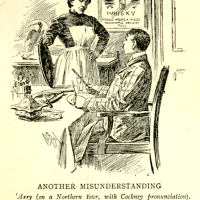Today is the 70th anniversary of the third installment of the weekly story that we now know as The Great Divorce. Week 1 and Chapter 1 were the same, so that a reader picking up the book today and a reader 70 years ago would have experienced the same thing, except that it was squeezed between editorials on organ music, advertisements for “Winox: The Meat and Malt Wine,” and reminders about the Church of England Waif and Strays Society. This clip of The Guardian from Nov 24, 1944 also includes “A Layman’s Quiz” with the final paragraphs of the 3rd installment: The Great Divorce is the second time that Lewis used The Guardian to print a small book in weekly form. With The Screwtape Letters, one letter was printed each week. Lewis was meticulous about length. If you visit the original Screwtape handwritten manuscript in the Berg Collection at the New York Public you will see that each letter is within a line in length of all the rest. The single exception is the last letter, where Screwtape waxes lyrical about Wormwood’s failure and the translation of the human soul into the heavenly realities.
The Great Divorce is the second time that Lewis used The Guardian to print a small book in weekly form. With The Screwtape Letters, one letter was printed each week. Lewis was meticulous about length. If you visit the original Screwtape handwritten manuscript in the Berg Collection at the New York Public you will see that each letter is within a line in length of all the rest. The single exception is the last letter, where Screwtape waxes lyrical about Wormwood’s failure and the translation of the human soul into the heavenly realities.
 The divisions in The Great Divorce are not so neat. For one thing, the kind of book is very different. The Great Divorce is a spiritual triptik. As Christian in The Pilgrim’s Progress or Odysseus in The Odyssey or Dorothy in The Wizard of Oz move from scene to scene encountering a new test in each new geography, the protagonist of The Great Divorce moves from character to character, hearing the story that either draws a soul heavenward or traps a soul hellward.
The divisions in The Great Divorce are not so neat. For one thing, the kind of book is very different. The Great Divorce is a spiritual triptik. As Christian in The Pilgrim’s Progress or Odysseus in The Odyssey or Dorothy in The Wizard of Oz move from scene to scene encountering a new test in each new geography, the protagonist of The Great Divorce moves from character to character, hearing the story that either draws a soul heavenward or traps a soul hellward.
Some of these stories are very brief. I have not yet read the book, but David G. Clark includes a chart at the end of C.S. Lewis Goes to Heaven: A Reader’s Guide to the Great Divorce that describes how much space each character gets. Some characters get 1/3 or 1/2 a page; one gets 13 pages of treatment. Sometimes Lewis delves deep into a character’s psychology; other times he allows the reader to create a caricature with a single phrase or a quick glance.
I am indebted to David Clark for the idea of creating a chart. Dr. Clark is a biblical scholar by training. With meticulous determination, Clark uses a series of appendices to C.S. Lewis Goes to Heaven to draw out a host of biblical, classical, and literary allusions in The Great Divorce. One of these charts includes a list of characters, their “sin” that makes adapting to the High Countries a challenge, and how much space is given to their story.
 Since it is such a great idea, I’ve used it to create my own list. I’ve adapted his characters a little bit, adding names or their accompanying spirits (when named). I’ve changed a number of the “sins,” not really because I disagreed, but in order to give a bit more depth. I’ve also added a “saying” that (I think) captures the ghost’s (anti-)spirituality in one quick breath.
Since it is such a great idea, I’ve used it to create my own list. I’ve adapted his characters a little bit, adding names or their accompanying spirits (when named). I’ve changed a number of the “sins,” not really because I disagreed, but in order to give a bit more depth. I’ve also added a “saying” that (I think) captures the ghost’s (anti-)spirituality in one quick breath.
Most significantly, though, I use this chart as a way to remember which week goes with which chapter of the book. For example, readers of the original series would have been left hanging halfway through a conversation at the midpoint of chapter 2. They would have had to wait a whole week for the next part of the story–almost an unheard of idea in our Netflix generation!
I had to split the chart in two. Send a tweet @BrentonDana if you want the actual file to twist into your own chart, as I have done. Do reference back, though, if you use it elsewhere. For those reading along with the original run of The Great Divorce 70 years ago, here are the weekly breakdowns. And for those who are wanting to submit a blog on The Great Divorce, you can use this chart to line up the dates for your submission. 























Such a poignant book. It’s time, I think, for me to re-read it. I remember the tragedian/Frank story was very painful to read, and I recall loving the manner in which Lewis portrayed MacDonald.
I quite love the audiobook, if you were into that kind of thing.
Very much! Audiobooks are the best thing for me, as reading takes a lot longer for me. 🙂
Pingback: Simon Vance’s Reading of “The Great Divorce” (an Audiobook Review) | A Pilgrim in Narnia
Pingback: Guest Blog: C.S. Lewis Goes to Heaven: William O’Flaherty’s Interview with David Clark | A Pilgrim in Narnia
Pingback: Love That Is Not Love: The Character of Pam in The Great Divorce | A Pilgrim in Narnia
Pingback: Finding that Elusive Title: The Many Names of The Great Divorce | A Pilgrim in Narnia
Pingback: A Review of “The Chapel of the Thorn,” a lost Charles Williams play by Sørina Higgins | A Pilgrim in Narnia
Pingback: ‘Arch-natural Psalms’: The Poetry of The Great Divorce (Guest Post by David Llewellyn Dodds) | A Pilgrim in Narnia
Pingback: Random Thoughts on my 400th Post! | A Pilgrim in Narnia
Pingback: The Top 12 Posts of All Time | A Pilgrim in Narnia
Pingback: Why I Read C.S. Lewis Chronologically | A Pilgrim in Narnia
Pingback: The Deeper Meaning of “The Great Divorce” (Feature Friday) | A Pilgrim in Narnia
Pingback: Reading the Great Divorce: Friday Feature Podcast | A Pilgrim in Narnia
Pingback: The Grand Miracle, Or Easter in Everyday Life | A Pilgrim in Narnia
Pingback: “The Planets” in C.S. Lewis’ Writing, with a Planet Narnia Chart (Throwback Thursday) | A Pilgrim in Narnia
Pingback: The Grand Miracle, Or Easter in Everyday Life with C.S. Lewis (75th Anniversary) | A Pilgrim in Narnia
Pingback: C.S. Lewis and the Total Eclipse of the Heavens, with An Unauthorized Book-Jacket Description of The Great Divorce - A Pilgrim in Narnia